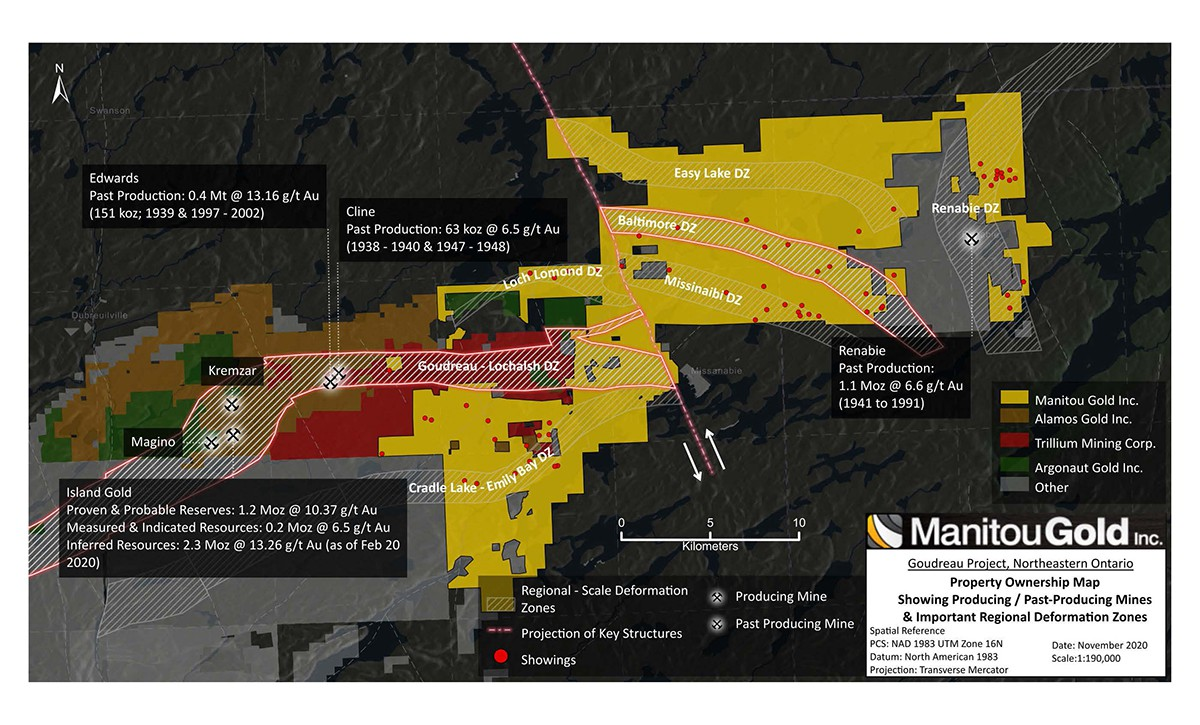Nov 6 2020
Manitou Gold has reported the commencement of diamond drilling of targets along the Baltimore deformation zone at its wholly-owned Goudreau Project, which is situated 50 km to the northeast of Wawa, Ontario.
 Location map of BDZ within Manitou’s Goudreau Project area. Image Credit: Manitou Gold
Location map of BDZ within Manitou’s Goudreau Project area. Image Credit: Manitou Gold
The aim of the drill program is to test recently identified targets along the interpreted fault-offset extension of the Goudreau-Localsh Deformation Zone. It is anticipated that the program will include no less than 5,000 m of shallow drilling.
Highlights
- The BDZ, which is a crustal-scale geologic structure, signifies the fault-offset continuation of the GLDZ. The GLDZ comprises Argonaut Gold’s Magino gold deposit (in development), Alamos Gold’s Island gold mine, as well as the past producing Cline and Edwards mines. On Manitou property, the BDZ extends east-southeast for 17 km.
- The plan for Q4 2020 and Q1 2021 is a minimum drilling of 5,000 m to test targets. Complete funding for the program comes from the approximately $4.2 million of cash in the company’s existing treasury.
- The focus of preliminary drilling will be to test a resistivity trend with higher chargeabilities close to the central axis of the BDZ. This trend spreads along strike from identified mineralization at the Stover occurrence. Just 3 of the 13 historical drill holes intersected the IP trend and comprised substantial grades of gold mineralization with grades up to 0.7 g/ton Au over 48.5 m. The remaining holes did not intersect the most potential target.
- Priority drill targets were generated by combining data from geophysical, geochemical, and geological surveys. Targets of highest priority exist along the sedimentary-volcanic contact, which is close to the central axis of the BDZ, and in areas with a higher density of northwest and northeast striking fault structures.
- A number of secondary targets are being inspected based on an evolving geological and structural insight of the area.
I am very pleased to be kicking off a major drilling campaign on the Baltimore Deformation Zone today. We have spent the past ten months doing the detailed work on the ground to identify and prioritize targets. I expect this initial phase of drilling on the BDZ to extend at least through the first quarter of next year.
Richard Murphy, President and CEO, Manitou Gold
Targeting of drill at the BDZ is based on the combination of aerial and ground magnetic surveys, an induced polarization (IP) survey, selective leach soil geochemistry (EDTA), as well as sampling work and ongoing trenching and mapping work finished during the 2020 field season. The incorporation of these datasets has produced several drill targets across the southeastern portion of the BDZ, which was the target of work done so far.
The maximum concentration of targets exists close to the intersection of a massive interpreted northeast-trending fault structure and the central axis of the Baltimore deformation zone. The BDZ has witnessed very less historic diamond drilling with a focus on the Stover occurrence, where the huge majority of drilling concluded in 1988. A number of Manitou’s priority targets are situated in the vicinity of the Stover occurrence.
The focus of preliminary drilling will be to test a 300- to 600-m-long resistivity trend with higher chargeabilities adjacent to the sedimentary-volcanic contact close to the central axis of the BDZ. This trend is parallel to, and extends along strike from, established mineralization at the Stover occurrence.
Fieldwork carried out in 2019 verified extensive gold mineralization at surface in pervasively modified, mineralized, and extremely deformed felsic to intermediate volcanic rocks and identified quartz veins, which yielded grab sample assay values ranging from below detection limit to a maximum of 6.1 g/ton gold.
Of the 13 historical drill holes, only 3 intersected the IP trend and included major grades of gold mineralization with grades up to 0.7 g/ton Au over 48.5 m (SL-88-01), while the rest of the holes seem to have missed the most potential target, which is still a priority follow-up target for future drilling by Manitou Gold.
Based on the successful defining of targets over the existing grid, the selective leach soil geochemical survey has been extended for about 6.5 km towards the west to encompass another 16 km2 of underexplored area along the BDZ.
The fraction of the BDZ included in this extended program is located across a series of volcaniclastic units that have witnessed greater deformation in a corridor between three younger felsic intrusions.
About the Goudreau Project
The Goudreau project is situated 50 km to the northeast of Wawa, Ontario and manifests Archean-aged rocks of the Michipicoten Greenstone belt. Many wide-scale deformation corridors crisscross the project area, including several of the crucial regional gold deposits and showings.
The Goudreau project encompasses about 338 km2 in this re-emerging gold camp that hosts Alamos’ Island Gold deposit and Argonaut Gold’s Magino deposit to the west and the past yielding Renabie mine to the east.
Manitou has about $4.2 million in its treasury and has strategic shareholders including O3 Mining and Alamos Gold.